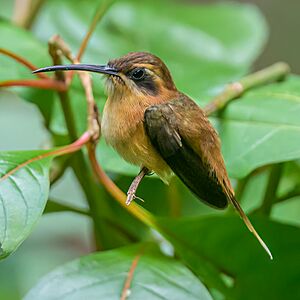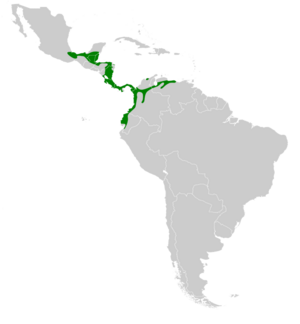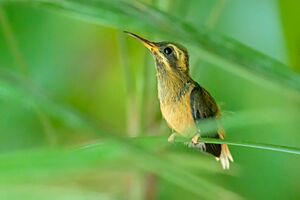Stripe-throated hermit facts for kids
Quick facts for kids Stripe-throated hermit |
|
|---|---|
 |
|
| Conservation status | |
| Scientific classification | |
| Genus: |
Phaethornis
|
| Species: |
striigularis
|
 |
|
| Range of P. striigularis | |
The stripe-throated hermit (Phaethornis striigularis) is a tiny hummingbird found in Central America and the north-western parts of South America. This bird is quite common. Experts at BirdLife International say it is of "Least Concern", meaning it is not currently in danger of disappearing.
Contents
About the Stripe-throated Hermit
What Does It Look Like?
This hummingbird is one of the smaller "hermits." It is about 9 to 10 centimeters (3.5 to 4 inches) long. It weighs only 2 to 3 grams (less than a tenth of an ounce)!
Its back, neck, and head are a dull, shiny green. Its rump (the area above its tail) is a light reddish-brown. The belly and sides are a pale yellow-brown. Its throat and central chest are light grayish-brown. You might see small, dark streaks on its throat, but they can be hard to spot.
The stripe-throated hermit has a black "bandit-mask" across its eyes. Above this mask is a whitish-yellow stripe, and below it is another whitish-yellow stripe. Its wing and tail feathers are dark. The tail feathers have white or yellowish tips. Like most hermits, it has a long, curved beak. The bottom part of its beak is yellow near its head, but the rest of the beak is black.
Male and Female Birds
Male and female stripe-throated hermits look almost exactly the same. Young birds, called juveniles, have a reddish-brown color all over their back.
The Hermit's Song
The male stripe-throated hermit sings a high-pitched, squeaky song. It can sound a bit boring because it repeats the same notes. The exact sound of the song changes a little depending on where the bird lives.
Where Do Stripe-throated Hermits Live?
This hummingbird lives in many countries. You can find it in southern Mexico, Belize, north-eastern Guatemala, Honduras, Nicaragua, Costa Rica, and Panama. It also lives in western, central, and northern Colombia. You can find it in western Ecuador and north-eastern Venezuela too.
These birds usually stay in the same area all year. However, they might move short distances sometimes.
Their Home and Habitat
Stripe-throated hermits live in many types of forests and woodlands. They can be found in clearings, thick bushes, and even gardens. They usually prefer places with lots of moisture. But sometimes, they live in drier areas where trees lose their leaves. They mostly live in lowlands and foothills. Very rarely, they have been seen high up in mountains, about 1,800 meters (5,900 feet) above sea level.
What Do Stripe-throated Hermits Eat?
This hummingbird mostly eats nectar from flowers. It flies from flower to flower, following a regular path, like a delivery route. This is called "trap-lining." Sometimes, if the nectar is too deep in a flower, the bird will poke a hole at the base of the flower to reach it. They also eat small insects. These birds usually look for food close to the ground, but sometimes they fly up to the top of the trees.
Reproduction and Life Cycle
Stripe-throated hermits are usually solitary birds. But when it's time to find a mate, the males gather in special spots called leks. Here, they sing loudly to attract females.
The female builds a small, cup-shaped nest. It is made of plant materials and held together with spiderwebs. The nest often has a "tail" hanging down from it. The female lays two eggs. She sits on the eggs to keep them warm for about 15 to 16 days until they hatch. The exact time of year they breed changes depending on the region. For example, in Ecuador, young birds that could fly were seen in early March.
Images for kids




